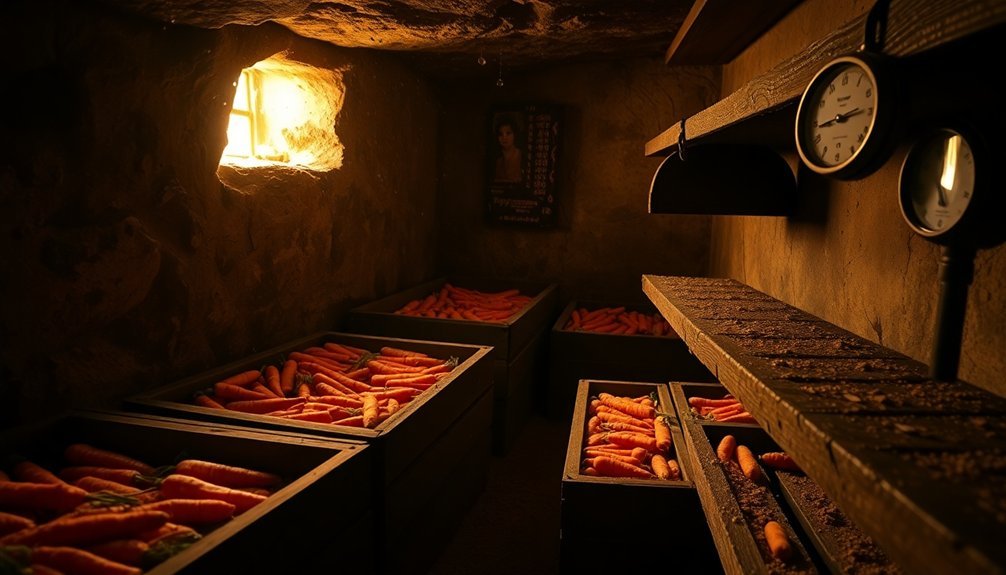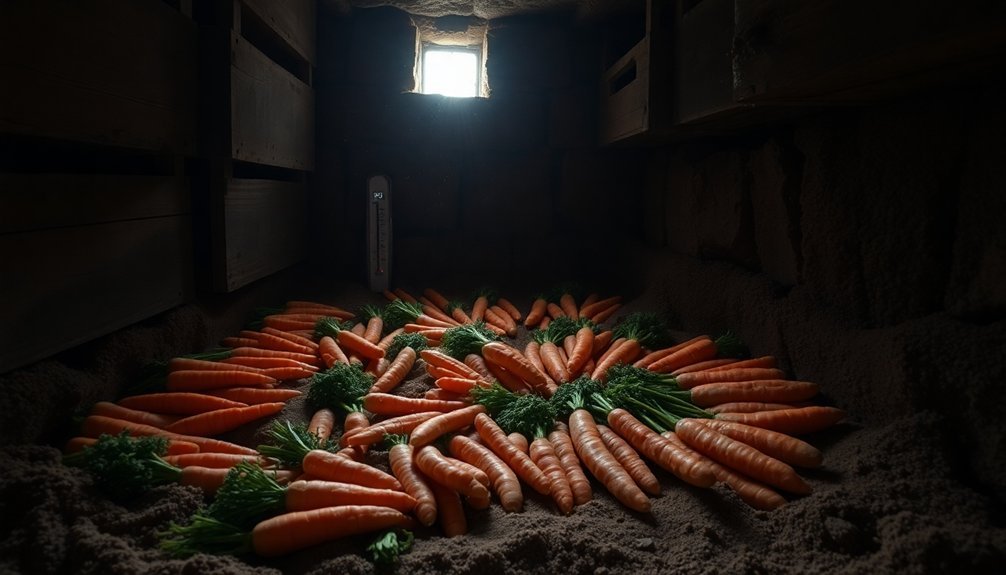You'll keep carrots fresh for months in your root cellar by mastering three essential storage techniques. First, maintain a consistent temperature between 32-40°F (0-4°C), with 33°F being ideal – use a reliable thermometer to monitor this daily. Second, create insulating layers using clean sand, straw, or fresh Sphagnum moss between your carrots to regulate moisture and prevent direct contact. Third, keep humidity levels between 90-95% by using a hygrometer and adjusting ventilation as needed. These fundamentals will get you started, but there's much more to maximizing your root cellar's preservation potential.
Maintain Perfect Temperature Balance

When storing carrots in your root cellar, maintaining a consistent temperature between 32-40°F (0-4°C) is vital for long-term preservation.
You'll want to aim for approximately 33°F, as this ideal temperature effectively slows down natural decay while preventing freezing or sprouting issues.
To achieve this preferred range, you can utilize several natural cooling methods. Consider building your root cellar underground or into a hillside to take advantage of the earth's natural insulation. Good drainage systems are essential when building underground to prevent water damage and temperature fluctuations.
You can also harness cool night air through strategic ventilation systems and store winter ice for summer cooling needs.
You'll need to monitor your cellar's temperature regularly using a reliable thermometer. If you notice temperatures dropping below 32°F, your carrots risk freezing and becoming unusable.
Conversely, if temperatures rise above 40°F, you'll face accelerated sprouting and decay. Keep detailed temperature records to help you identify and address any concerning patterns.
Install fans or adjustable vents to maintain consistent air circulation throughout your cellar.
This helps prevent temperature fluctuations and guarantees even cooling across all storage areas.
Layer With Natural Materials
Several natural materials serve as excellent insulation layers for storing carrots in your root cellar.
You'll find that proper layering helps maintain ideal humidity while preventing your carrots from touching each other, which could lead to rot or damage. Root cellars maintain stability by keeping temperatures consistently cool throughout seasonal changes.
1. Straw or leaves provide excellent insulation when you're creating storage mounds.
Layer them alternately with your carrots, ensuring a thick top layer to protect against temperature fluctuations.
2. Clean sand works perfectly in containers, where you'll want to start with a two-inch base layer before adding carrots.
Don't let the carrots touch each other as you continue alternating sand and vegetable layers.
3. Fresh Sphagnum Moss offers superior hydration properties.
You'll want to harvest it the same day as your carrots, creating thick layers between each row of vegetables and covering the top with a breathable plastic bag.
4. Untreated wood shavings, especially cedar, provide antimicrobial benefits while regulating moisture.
Layer them in your storage containers, placing carrots in single layers and repeating until full.
Remember to store your layered containers in a cool, well-ventilated area to maximize preservation time.
Monitor Humidity Levels

Your root cellar's humidity levels play an essential role in preserving carrots long-term. You'll want to maintain humidity between 90-95% to prevent your carrots from drying out and losing their fresh, crispy texture. Using a hygrometer, you can easily track these levels and make necessary adjustments to create conditions that mirror autumn's natural environment. Early morning harvesting will help maintain optimal moisture content in your carrots before storage.
If you notice humidity dropping too low, your carrots will begin to wither, becoming less flavorful and nutritionally diminished. Combat this by incorporating insulation materials like straw, hay, or wood shavings, which help stabilize moisture levels.
You'll need to balance proper ventilation with maintaining high humidity to prevent excess moisture buildup while keeping ethylene gas from accumulating.
Don't forget to pair humidity control with appropriate temperature management, keeping your storage area between 32-40°F (0-4°C). You can achieve this balance in a well-designed root cellar, garage, or even by utilizing earth's natural insulation in a hillside storage space.
Remember not to wash your carrots before storage, as their natural moisture helps maintain ideal conditions. Check your hygrometer readings regularly and adjust your ventilation or insulation as needed to keep your carrots fresh and crisp.
Frequently Asked Questions
Can Carrots Be Stored Alongside Potatoes in the Same Root Cellar Space?
You can store carrots alongside potatoes since they share similar storage needs – temperatures of 32-40°F and 90-95% humidity. Just guarantee proper ventilation and monitor regularly for any signs of spoilage.
How Do You Prevent Carrot Tops From Re-Sprouting During Storage?
You'll prevent carrot tops from re-sprouting by trimming them to about 1/2 inch above the crown. Don't cut into the crown itself, and store them in darkness to discourage any new growth.
Should You Wash Carrots Before Storing Them in a Root Cellar?
Don't wash your carrots before storage. You'll want to leave some soil attached as a natural barrier. Just brush off excess dirt and let them dry thoroughly to prevent moisture buildup that leads to spoilage.
What's the Best Container Material for Storing Carrots Long-Term?
You'll get the best results storing carrots in plastic buckets or wooden bins with layers of damp sand or sawdust. They'll keep your carrots humid and prevent rot while allowing proper air circulation.
How Often Should Root Cellar Carrots Be Rotated or Checked?
You'll need to check your stored carrots weekly for signs of spoilage. Remove any soft or rotting ones immediately. During checks, rotate the containers to guarantee even air circulation and maintain consistent humidity.
In Summary
You'll find your carrots staying fresh for months when you follow these essential root cellar practices. By maintaining temperatures between 32-40°F, layering your vegetables with sand or sawdust, and keeping humidity at 90-95%, you're creating ideal storage conditions. Check your cellar regularly to catch any issues early. With these methods, you'll enjoy crisp, flavorful carrots well into winter.





Leave a Reply